West Bengal is famous for its lively festivals that really highlight the state’s deep cultural heritage and traditions. Among these, Durga Puja, Kali Puja, Saraswatija, and Poila Boishakh stand out as events you shouldn’t miss. These celebrations have a way of bringing folks together, filling everyone with communal happiness. With each festival comes its own set of rituals and decorations that are special in their own right; they’re definitely worth checking out if you find yourself in West Bengal, India. It’s important to note that these aren’t just religious gatherings but also cultural ones where the artistry, music, and dance specific to this region take center stage. By joining in on these festivities, visitors get a real taste of local life and can experience firsthand the dynamic spirit of West Bengal.
Among these celebrations is Durga Puja – it’s huge! Imagine streets filled with massive structures called pandals that house stunning statues of Goddess Durga. This festival isn’t just about having a good time; it symbolizes the victory of goodness over bad vibes and draws crowds from all corners of the globe. There’s dancing, singing along with lots to eat during this festivity, and the immersion of the Durga idols in the Hooghly River on the final day of the festival is the main attraction of Durga Puja. Millions of people are witnessing this incredible occurrence.
Table of Contents
ToggleWhat are the major festivals celebrated in West Bengal?
Major festivals celebrated in West Bengal include Durga Puja, Diwali, Kali Puja, Holi, Poila Boishakh (Bengali New Year), and Rath Yatra. These festivals showcase the rich cultural heritage and diversity of West Bengal, attracting tourists from all over the world to experience the vibrant celebrations.
These events do more than honor gods; they knit communities closer showcasing unity through diversity making them perfect times for anyone wanting to dive into what makes West Bengal truly special.
Explore the 13 Vibrant Festivals of West Bengal
West Bengal is famous for its lively and varied festivals that happen all year round. These events, ranging from religious to cultural gatherings, unite folks while displaying the state’s deep-rooted heritage. Let’s dive into the 12 festivals in West Bengal you shouldn’t miss:
1. Durga Puja – The Heartbeat of Bengal
In West Bengal, Durga Puja is the biggest celebration there is. It’s all about honoring Goddess Durga and her victory over bad stuff, along with her clan that includes Lord Shiva, Lord Ganesha, Goddess Saraswati, and Lord Kartikeya. This event usually happens in October and it’s famous for its elaborate pandals – those are special temporary structures set up to keep the idols of Goddess Durga and her family. These pandals aren’t just any ordinary setups; they’re beautifully crafted with lots of detail, drawing crowds who come to pray and get blessings. Alongside this spiritual side, there’s a lot of cultural action too – think music, dance performances, and plenty of good food! When Durga Puja rolls around, you can feel the excitement everywhere in Bengal; it turns into one big party that you wouldn’t want to miss if you’re visiting during that time.

2. Kali Puja – A Night of Lights and Fireworks
In West Bengal, Kali Puja, also known as Diwali, is celebrated with a lot of excitement and it’s one of the most important Hindu festivals in the region. This festival honors Goddess Kali, who is famous for her strength and the ability to defeat bad vibes. During this time, people light up lamps and fireworks, pray to the goddess, wear new clothes, and share gifts and sweets with their dear ones. It’s all about spreading happiness and coming together to enjoy the victory of good over evil. With fireworks brightening up the night sky and a joyful atmosphere everywhere you go in Bengal during this period, Kali Puja is truly a festival of lights and a celebration of joyous moments.

3. Saraswati Puja – Celebrating Knowledge and Wisdom
In West Bengal, Saraswati Puja is a big deal. Also Known as Basant Panchami. It’s all about showing respect to Saraswati, the goddess who knows a lot about knowledge, music, and arts. This special day falls in February during Vasant Panchami – that’s the fifth day of Magha according to the Hindu calendar. On this occasion, students get really hopeful for doing well in their studies and ask for good luck from the goddess.
For this festival, everyone puts on their nicest clothes and heads over to puja pandals. These are temporary setups where people go to pray and wish for blessings from Saraswati. With lots of flowers around and fancy decorations making everything look pretty awesome; it’s quite a sight! Besides praying there are also cultural events with music that people enjoy participating in or watching.
Saraswati Puja stands out as an important time for anyone looking forward to success in education while living in Bengal or even just visiting during February should definitely not miss experiencing this celebration filled with hopefulness towards academic achievements.
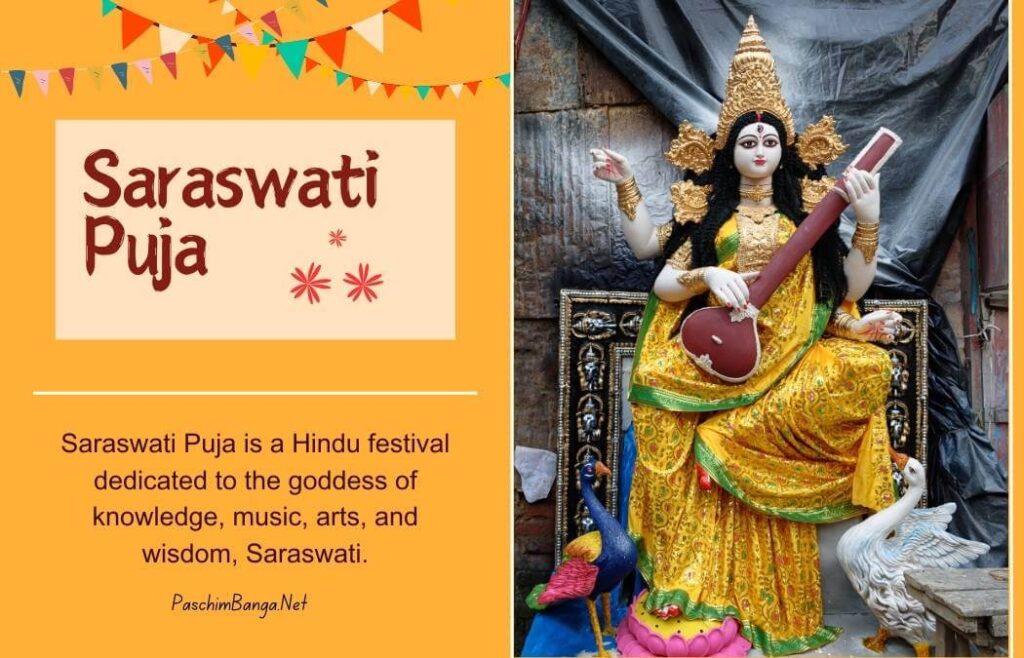
4. Poila Boishakh – Bengali New Year Celebrations
Poila Boishakh, or the Bengali New Year as it’s widely known, is a big deal in West Bengal. It happens every April and kicks off the start of their calendar year. On this day, everyone gets dressed up in new clothes and heads to temples to pray for good luck in the year ahead. With cultural events like music and dance shows plus food stalls everywhere, it’s a full-on celebration of Bengal’s rich traditions. People really come together during Poila Boishakh to enjoy traditional Bengali foods and embrace the spirit of starting fresh. If you’re ever in West Bengal around this time, joining in on these festivities is something you shouldn’t miss.
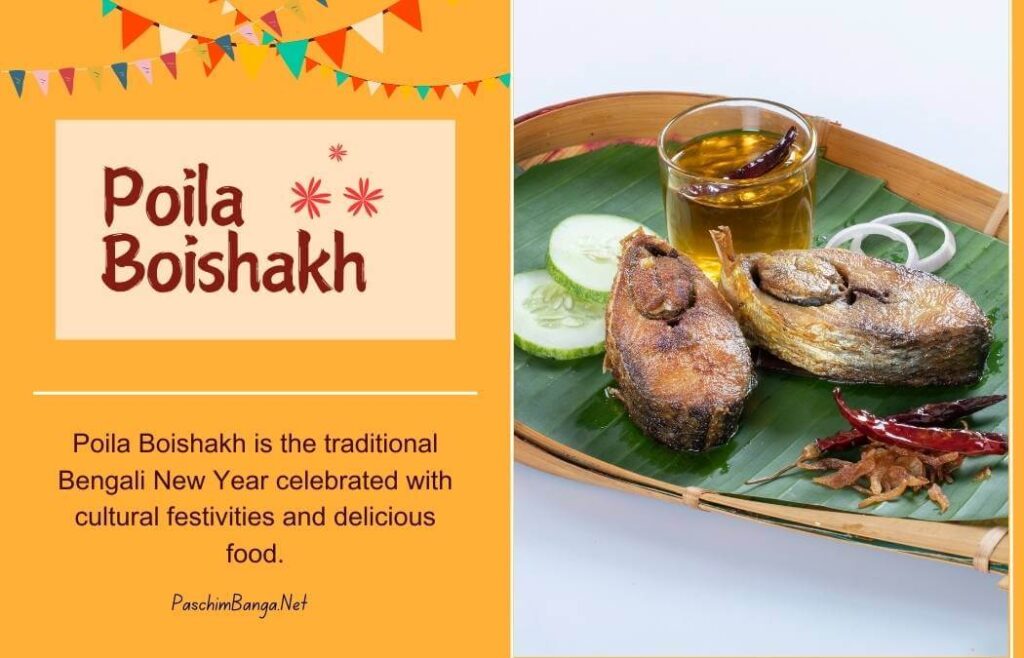
5. Rath Yatra – Chariot Procession in Honor of Lord Jagannath
In West Bengal, there’s a big celebration called Rath Yatra, or the Chariot Festival. It happens in July to show love and respect for Lord Jagannath and his consort Radha. During this festival, large crowds come together as three richly decorated chariots carry the idols of Lord Jagannath and Radha along with his sister Subhadra and brother Balarama through the streets. Devotees pull these chariots while music plays, people dance, and hymns are chanted all around them. With thousands of pilgrims joining in, it’s not just a religious event but also a huge party that anyone visiting Bengal shouldn’t miss out on.
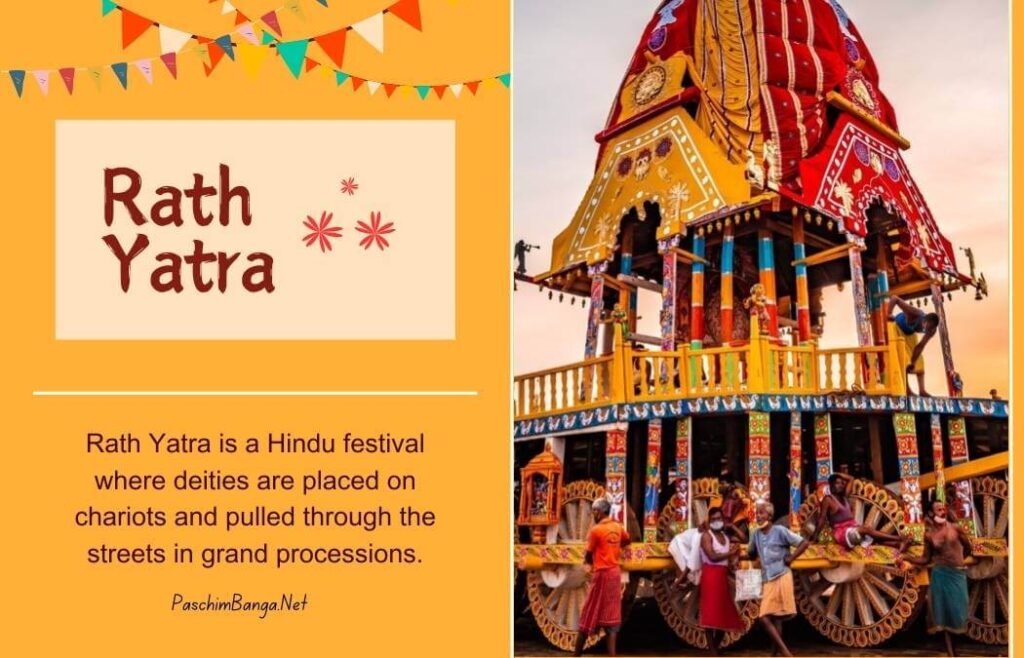
6. Dol Purnima/Holi – Festival of Colors
Dol Purnima, also known as Holi or Dol Jatra, lights up West Bengal with its colors to celebrate the joyous arrival of spring. This festival, which usually falls in March, honors the love between Radha and Krishna and involves everyone throwing colored powders and water at each other. With traditional music playing in the background, people gather to dance, eat sweet treats and delicacies specific to this time. The atmosphere buzzes with laughter and happiness as folks enjoy smearing color on one another’s faces. Dol Purnima, or Dol Jatra, represents a period of sheer enjoyment and festivity that anyone visiting Bengal shouldn’t miss out on experiencing.
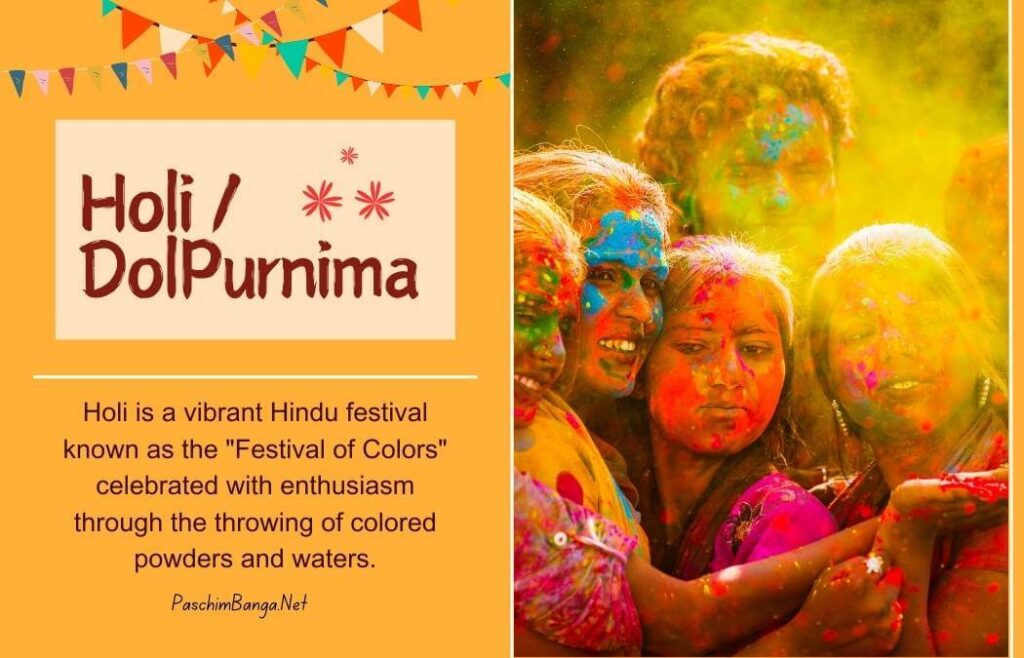
7. Eid-ul-Fitr – A Celebration of Peace and Brotherhood
In West Bengal, the Muslim community celebrates Eid-ul-Fitr with a lot of joy. This festival comes after Ramadan, which is a month where people fast and pray. During Eid-ul-Fitr, families get together to enjoy good food and give each other presents. It’s all about peace and feeling like one big family; everyone goes to mosques for prayers hoping for blessings. The idea is to share love and happiness during this time. If you’re keen on seeing how diverse West Bengal can be, being part of Eid celebrations is something you shouldn’t miss.
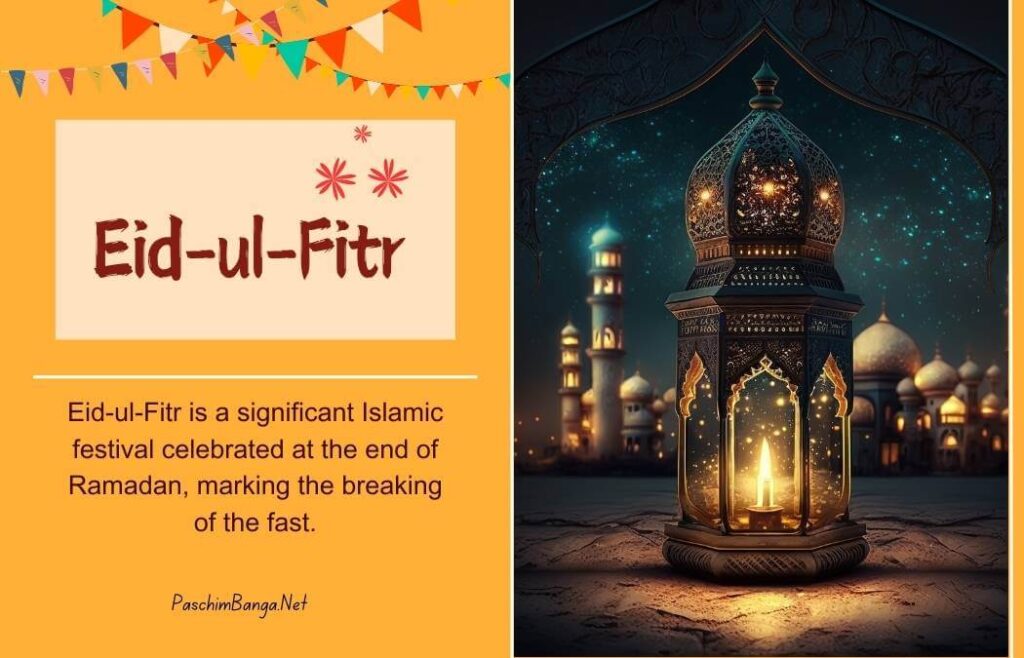
8. Ganga Sagar Mela – Pilgrimage and Fair at Sagardwip
The Ganga Sagar Mela, also known as the Gangasagar Fair, is a big deal in West Bengal. It happens every January at Sagardwip where the River Ganges meets the Bay of Bengal. At this time, lots of people from all over come to take a holy bath in these special waters during the Makar Sankranti festival and ask for blessings. Along with that, there are plenty of cultural events like music and dance shows going on. This mela isn’t just about religion; it’s also a celebration filled with joy and culture. If you’re ever in West Bengal during this time, attending the Ganga Sagar Mela is something you shouldn’t miss out on.
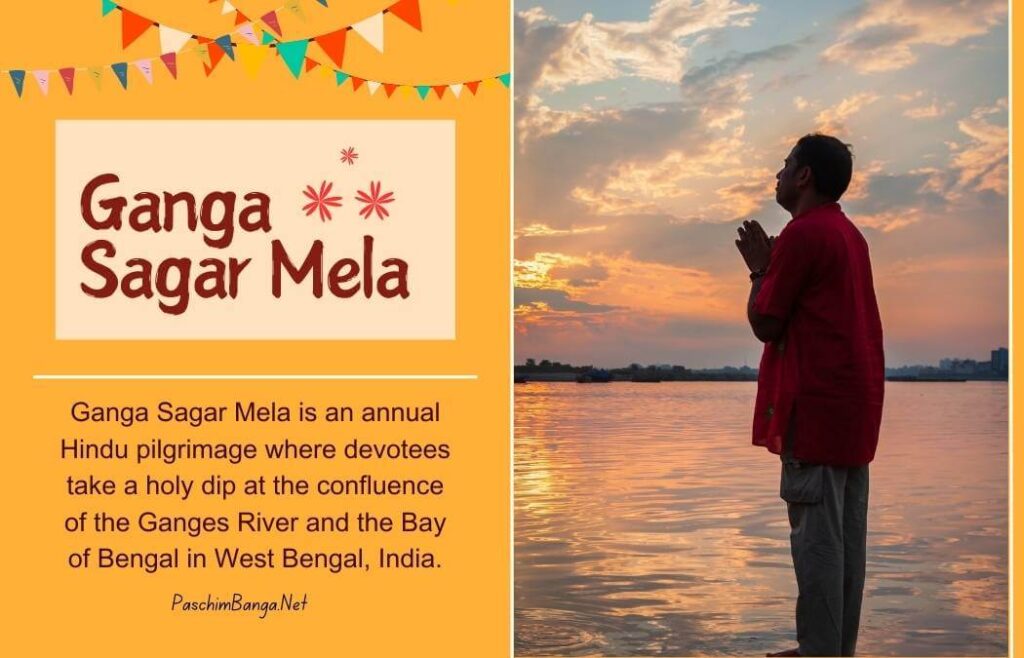
9. Poush Mela – A Cultural Fiesta in Shantiniketan
In December, the town of Shantiniketan in West Bengal comes alive with Poush Mela, a vibrant and unique harvest festival. This festival is all about celebrating Bengal’s rich cultural traditions and is believed to honor the birth of the author of Geeta Govindam, Joydev. At this time, artists and musicians from different parts come to share their talents through music, dance, and art shows. With performances that light up the stage and exhibitions that showcase creativity, Poush Mela honors Rabindranath Tagore’s legacy—the poet who founded Visva-Bharati University here. For anyone keen on diving into the colorful cultural heritage of Bengal, attending this mela is a must.
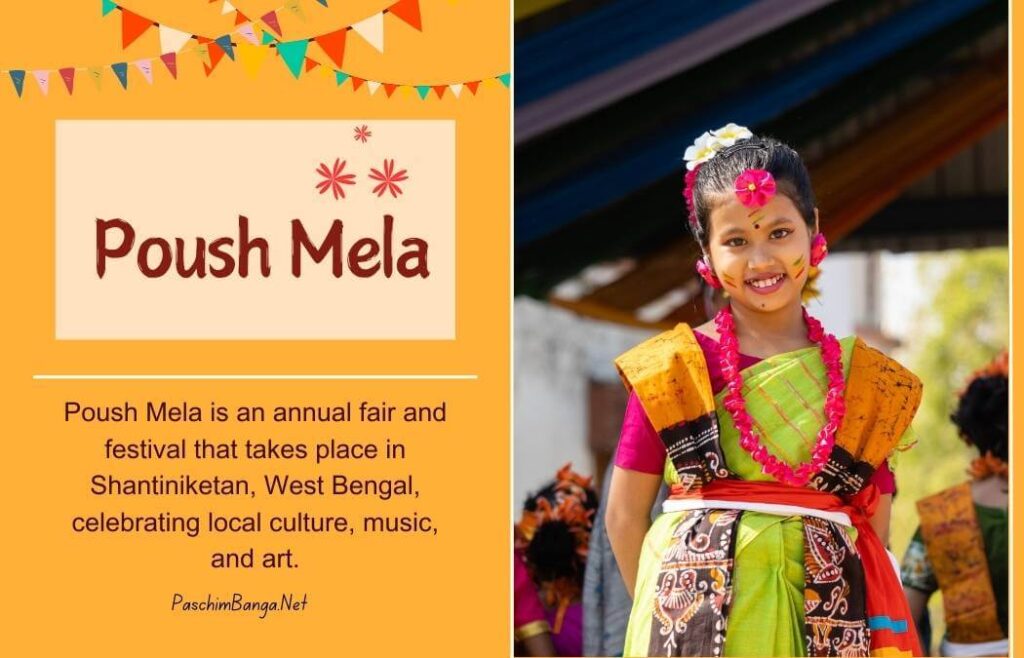
10. Jagadhatri Puja – Worship of the Protector of the World
In West Bengal, there’s this big celebration called Jagadhatri Puja where everyone comes together to honor the goddess Jagadhatri, who is seen as the world’s protector. This event usually happens in November and it’s all about showing love and respect to the goddess inside these really fancy tents known as pandals. The statues of the goddess get dressed up with some pretty amazing jewelry and clothes. People come to pray, ask for blessings, and just be part of something special. It’s a time when everything feels grand but also deeply spiritual. Everyone gets into it with lots of happiness and excitement because it’s not just any festival; it brings folks together in a unique way that highlights how powerful this divine figure is for them. If you ever find yourself in Bengal around this time, going to see Jagadhatri Puja should definitely be on your list.
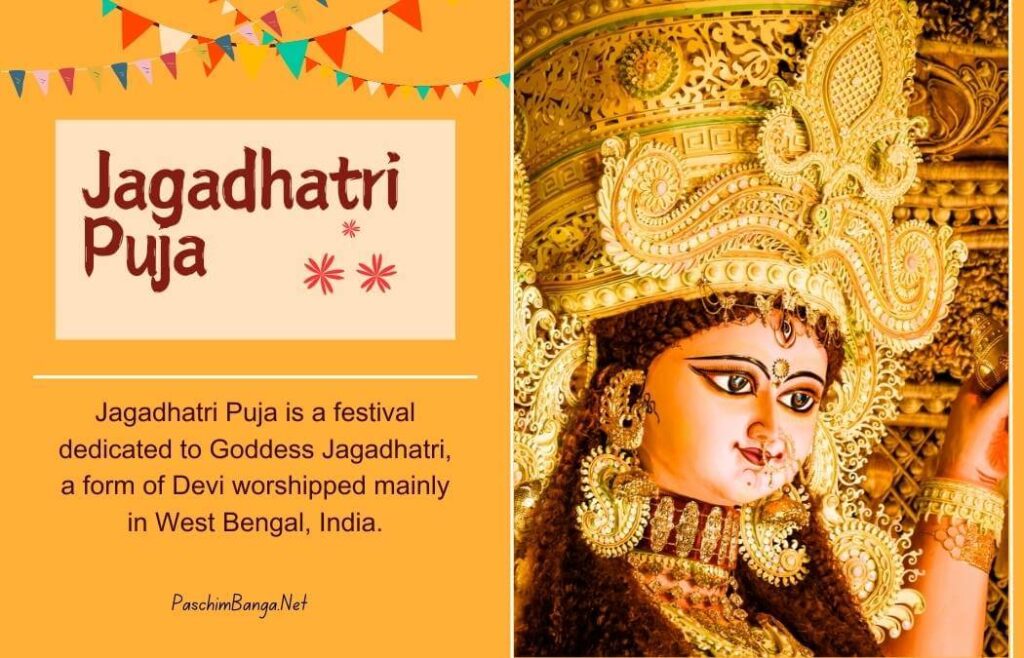
11. Bhai Phonta – Celebrating the Brother-Sister Bond
In West Bengal, there’s a special day called Bhai Phonta, or some might know it as Bhai Dooj. It’s all about making the bond between brothers and sisters stronger. This festival falls in October every year. During this time, sisters put a tilak on their brothers’ foreheads and do an aarti for them. They also give sweets and presents to their brothers who then return the favor by giving gifts back to their sisters. Bhai Phonta is really about celebrating that unique love siblings share with each other, making it an event you shouldn’t miss if you’re in Bengal during this time.

12. Lakshmi Puja – The Goddess Of Prosperity
Lakshmi Puja is a traditional Hindu ritual dedicated to the worship of Goddess Lakshmi, the deity of wealth, prosperity, and fortune. This auspicious ceremony is typically performed during Diwali, the festival of lights, as it is believed that invoking Goddess Lakshmi’s blessings during this time brings in wealth and abundance for the upcoming year.
During Lakshmi Puja, devotees decorate their homes with colorful rangolis, light oil lamps (diyas), and offer prayers and hymns to honor Goddess Lakshmi. It is customary to clean and decorate the puja area with flowers, incense, and sweets as offerings to the goddess. Many people also perform aarti (a ritual of waving lit lamps) to seek her blessings.
Apart from seeking material wealth, Lakshmi Puja is also a spiritual practice that symbolizes inner transformation and the pursuit of righteousness. It is believed that by invoking Goddess Lakshmi, one can attain not only financial prosperity but also spiritual enlightenment and emotional well-being.
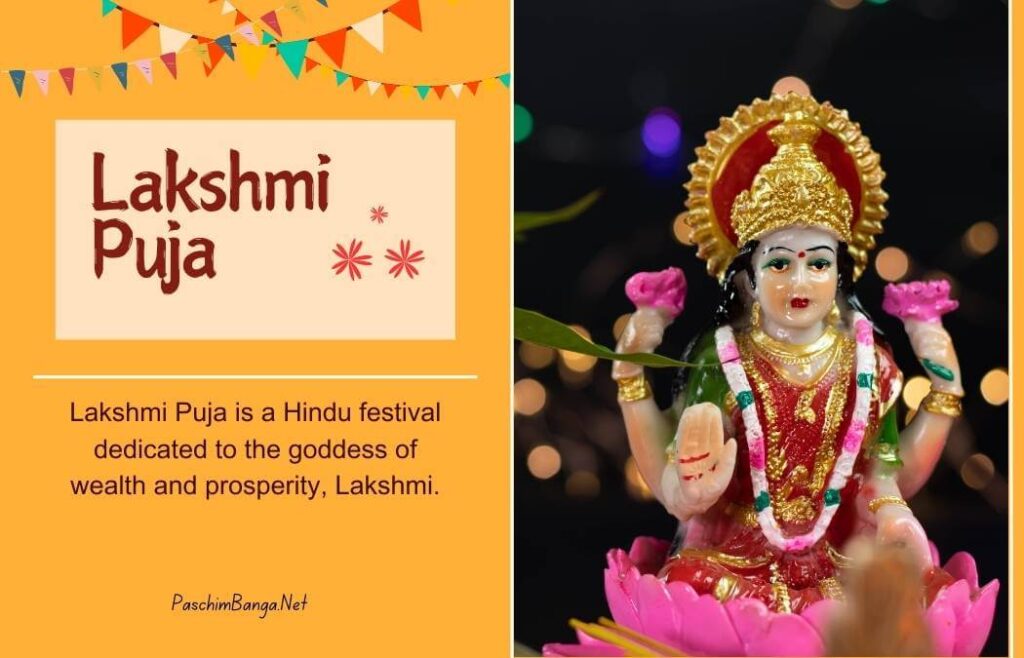
13. Jamai Shoushti
Jamai Sasthi is a traditional Hindu Bengali festival that celebrates the bond between a son-in-law and his in-laws. It is observed on the sixth day of the Shukla Paksha (waxing phase of the moon) in the month of Jaishtho according to the Bengali calendar. On this day, daughters invite their husbands to their parental homes for a special feast to honor and pamper them. The mother-in-law performs rituals for the well-being and longevity of her son-in-law, followed by a grand meal where various delicacies are prepared. This festival holds great significance in Bengali culture, emphasizing respect and harmony within extended families. Over time, Jamai Sasthi has evolved into a joyous occasion filled with love, laughter, and delicious food, strengthening familial bonds and traditions.
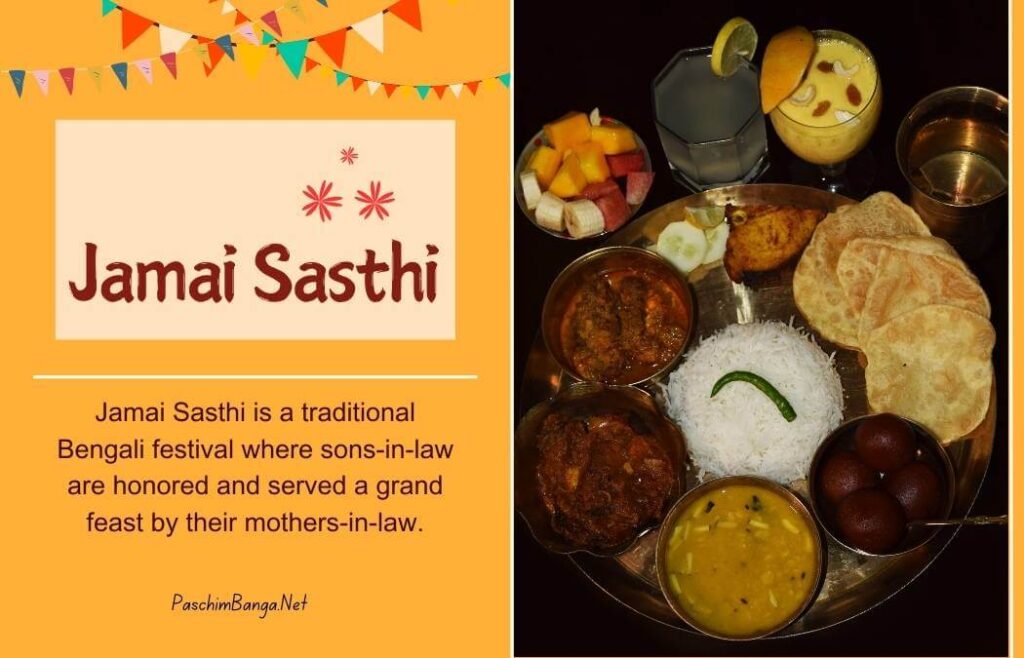
Conclusion
In West Bengal, the festivals are full of life and show off the area’s rich culture and traditions. From the grand Durga Puja to the fun-filled Holi, every festival offers a special experience. With Basant Panchami, you get to see everything in vibrant colors or take part in Ganga Sagar Mela’s pilgrimage; these events bring people together in celebration. During Bhai Phonta, siblings strengthen their bond while Eid-ul-Fitr is celebrated with peace and joy. By taking part in these festivals, you dive into West Bengal’s cultural heritage and enjoy moments that stick with you forever. You also get a taste of local flavors that highlight what makes West Bengal festive times so heartwarming.
Frequently Asked Questions
What is the Best Time to Experience Festivals in West Bengal?
In West Bengal, festivals happen all year round, but the biggest ones are in September and October. During this period, people celebrate Durga Puja, Kali Puja, and Lakshmi Puja with a lot of enthusiasm. There are other celebrations too like Saraswati Puja in January and Basanta Utsav (which is another name for Holi) when March comes around. These events draw visitors from different parts of the world who want to dive into the rich culture and traditions that Bengal has to offer. So if you’re thinking about visiting West Bengal, checking out these festival dates might be a good idea to get the full experience.
How Can Tourists Participate in Durga Puja Celebrations?
- By heading to Kolkata, tourists get the chance to dive into Durga Puja festivities. They can check out the famous temporary setups known as pandals.
- At these spots, you’ll find yourself surrounded by stunning decorations and sculptures of Goddess Durga that are just a feast for the eyes. Plus, there’s no shortage of cultural shows to enjoy.
- For those visiting, it’s an opportunity to soak up all that festive vibe. You get to see how traditional rituals unfold right before your eyes alongside some really lively music and dance acts.
- To make sure you don’t miss out on anything cool, it’s wise to plan your trip early. Roaming around different pandals lets you witness a variety of artistic talents showcased during this special time called Durga Puja.
Are There Any Traditional Foods Associated with These Festivals?
In West Bengal, no festival feels complete without the special traditional dishes that come with it. With Bengali cuisine, there’s a huge selection of sweets and snacks made especially for these celebrations. Among the favorites are rasgulla, sandesh, mishti doi, pitha, and mughlai paratha. For tourists looking to dive into the local culture through their taste buds can really enjoy these tasty treats and experience the rich food heritage of Bengal.
What Cultural Significance Do These Festivals Hold?
- In West Bengal, festivals are a big deal because they show off the state’s culture and history.
- By bringing folks together, these events strengthen community ties and make everyone feel united.
- With music, dance, and art on full display during these times, people get to see how rich West Bengal’s cultural traditions really are.
- These celebrations also remind us of the deep cultural roots in Bengal and highlight why it’s important to keep celebrating and preserving these customs.
How Do Festivals in West Bengal Promote Community Bonding?
In West Bengal, festivals are a big deal because they help bring people closer and make the community stronger. With lots of excitement and happiness, everyone in the community joins hands to celebrate these occasions. During these times, families and friends meet up to enjoy cultural shows and eat traditional foods together. These celebrations play a huge part in creating feelings of unity and belonging among folks in Bengal, making their bond as a community even tighter.
Tips for Visitors Attending West Bengal’s Festivals
If you’re heading to West Bengal’s festivals, here are some tips to help you get the most out of your visit:
- When it comes to what to wear, either go for traditional outfits or choose something comfy that fits the festival vibe.
- Before you go, do a bit of homework. Look up different pandals and event spots so you can plan your time well and catch the highlights.
- With all the people around, things can get pretty packed. Try getting there early or pick times when it’s not as busy if you want a smoother experience.
- Keeping safe is key. Watch over your stuff, drink plenty of water, and stick to any safety advice from those in charge.
- It’s important to show respect for local ways. Always ask before taking photos or joining in on rituals.
- To really soak in everything West Bengal has got going on during these festivities: chat with locals; taste their food; let yourself dive into all that color and energy.
By following these suggestions while exploring West Bengal, visitors will surely enjoy every moment at its vibrant festivals amidst bustling pandals filled with festive cheer!
What Should Tourists Know About the Dress Code During Festivals?
When visiting festivals in West Bengal, it’s important for tourists to be aware of the local culture and dress in a way that shows respect. Wearing traditional clothes or outfits that fit well with the festival’s cultural norms is a good idea. For most events in West Bengal, choosing modest attire that covers your shoulders and knees works best. By steering clear of clothing that reveals too much or could be seen as disrespectful, you’ll help make sure everyone has a positive and respectful time during the celebrations.
How to Navigate Crowds and Stay Safe During Major Festivals?
In West Bengal, major festivals often draw big crowds. To stay safe, it’s key to figure out your travel plans early. This means knowing how you’ll get there and picking paths that steer clear of packed places. With so many people around, keeping an eye on your stuff is crucial to make sure nothing gets lost or stolen. Always stick to the safety rules set by those in charge and do what you need to keep yourself out of harm’s way. When it comes to getting around during these busy times, using public transport or finding a spot in designated parking areas can really help dodge traffic jams and parking headaches at these big events in Bengal.
Why are the festivals in Kolkata so famous?
In Kolkata, festivals are known for their grandeur and cultural importance. With Durga Puja at the heart of it all, the city comes alive with enthusiasm. You’ll see amazing decorations, artistic sculptures, and a bunch of cultural events happening everywhere. The festive spirit in Kolkata is something else because people there really love their art, music, and culture. This makes these celebrations stand out and well-known all over the country.
What is the folk festival of West Bengal?
In West Bengal, there’s a folk festival known as Kenduli Mela. This event is all about celebrating the region’s traditional music and dance. Baul musicians and other performers take this opportunity to show off their skills. With its lively performances, Kenduli Mela draws in crowds of people eager to dive into the rich folk culture of Bengal.
What is the biggest festival of Bengali?
For Bengalis, Durga Puja is the highlight of their year. This festival lights up West Bengal and Kolkata in October with its grand celebrations. It’s a time when people come together to celebrate Goddess Durga’s victory over Mahishasura, marking it with days filled with stunning decorations, cultural events, and big community get-togethers.
What is the most famous festival of North Bengal?
In North Bengal, the Darjeeling Tea and Tourism Festival stands out as the most celebrated event. With a focus on the area’s deep-rooted tea culture and heritage, this festival highlights Darjeeling’s picturesque landscapes, lush tea gardens, and lively customs. Tourists from across the globe are drawn to these festivities to soak in North Bengal’s distinct allure and enjoy what it has to offer.
